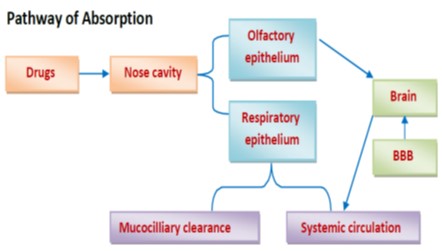A comparative clinical study to evaluate the efficacy of classical Dhuma Nasya and modified Dhuma Nasya (in the form of nebulization) in Tamaka Swasa (Bronchial Asthma)
DOI:
https://doi.org/10.21760/jaims.8.10.1Keywords:
Dhuma Nasya, Prana Vayu, Shatyadi Dravyas, Tamakaswasa, YapyaAbstract
Background: Bronchial asthma is well-known hypersensitivity disorder which prevalence is being rapidly intensified in present world particularly in developed countries. Tamaka Swasa is correlate with Bronchial asthma, symptoms of Tamaka Swasa is nearly similar to Bronchial asthma. Tamaka Swasa can be treated by Nasya Karma followed by classical Dhuma Nasya and modified Dhuma Nasya (in the form of Nebulization) as Nasa is considered as Shiraso Dwara will be effective to reduce symptoms and controlling Prana Vayu. Aim: To compare the efficacy of classical Dhuma Nasya with Modified Dhuma Nasya (in the form of nebulization) in Tamakaswasa (Bronchial asthma). Materials and Methods: Total 40 patients of Tamakaswasa in the age group of 20 to 50 years fulfilling the inclusion criteria were selected for trial & randomly distributed in Group A and Group B. Result: Statistically Group B was found more effective than Group A in the management of symptoms of Tamakaswasa. Discussion: Properties having Shatyadi Dravyas (6 drugs among Charakokta Swasahara Mahakashaya) is Tikta Katu Rasa, Laghu and Tikshna Guna, Ushna Virya and Vatakaphagna (decrease Vata and Kapha Dosha). Shatyadi Dravyas is effective in break down the Samprapti of Tamakaswasa and Nebulization procedure can dispense the drug directly into the target organ through inhalation. Hence the study proves its effectiveness in restoring the vital capacity of lungs.
Downloads
References
Pandit Kashinath Shastri, Dr. Gorakhnath Chaturvedi. Charak samhita of Agnivesha. Chikitsasthan, Chapter 17, Sloka 45. In: Savimarsh Vidhyotni-Hindivyakha. Varanasi: Chaukamba Bharti Academy; [year of publication].
Mohan H. Text of Pathology. 5th edition. New Delhi: Jaypee Brothers Medical Publishers (P) Ltd; 2005. p. 491.
World Health Organization. [Internet]. Geneva: WHO; [date of publication] [cited date]. Available from: http://www.who.int
Trikamji AY, editor. Charak Samhita of Agnivesha with Ayurveda Dipika commentary of Chakrapanidatta. Chikitasa Sthana, Chapter 17. Reprint edition. Varanasi: Chaukhambha Prakashan; 2011. p. 535.
Paradkar HS, editor. Astanga Hridaya of Vagbhatta with Sarvangasundra commentary of Arunadatta & Ayurvedarasayana of Hemadri. Nidana Sthana, Chapter 4, Ver. 10, 6th ed. Varanasi: Chaukhambha Surbharati Prakashan; 2014. p. 473.
Trikamji AY, editor. Charak Samhita of Agnivesha with Ayurveda Dipika commentary of Chakrapanidatta. Chikitasa Sthana, Chapter 17, Verse 11. Reprint edition. Varanasi: Chaukhambha Prakashan; 2011. p. 533.
WHO/IAC informal consultation on the Asthma Guidelines Implementation Project – April 1-2/1998. Report of the WHO; Toronto, Canada. Available from: http://www.globalasthmareport.org/burden/burden.php
The Global Asthma Report 2014. [Internet]. Available from: www.globalasthmareport.org/resources/Global_Asthma_Report_2014.pdf
[Internet]. Times of India. Available from: http://timesofindia.indiatimes.com/home/articleshow/12934160.cms
Global Initiative for Asthma. Report Item. [Internet]. Available from: http://www.ginasthma.org/ReportItem.asp?l1=2&l2=2&intId=94)
Charaka Samhita. Chikitsasthana. Chapter 17, Verse 6.
Charaka Samhita. Chikitsasthana. Chapter 17, Verse 9.
Shrivastava SS. Ashtangsangrah Sutrsthan. Chapter 24, Sloka 3-4. Vyakhyakar. Varanasi: Chaukamba Orientalia; [year of publication]. p. 386.
Sharma PV. Charaksamhita of Agnivesha. Sutrasthan, Chapter 22, Sloka 18. English translation. Varanasi: Chaukamba Orientalia; [year of publication].
Vaidya SL. Ashtanghridya of Vagbhatta. Sutrasthan, Chapter 1, Sloka 25. Sarvangsundri Vyakhya Vibhushitam.
Shrivastava SS. Sharangdhar Samhita Uttartantra. Chapter 8, Shlok 2, 11.24. Sarvangsundri Vyakhya Samhita. Varanasi: Chaukambha Orientalia; [year of publication].
Shastri SN. Charak Samhita of Agnivesha. Chikitsasthan, Chapter 17, Sloka 62. Elaborated Vidyotini Hindi commentary. Varanasi: Chaukhambha Bharti Academy; Reprint 2017.
Shastri SN. Charak Samhita of Agnivesha. Sutrasthan, Chapter 4, Sloka 37. Elaborated Vidyotini Hindi commentary. Varanasi: Chaukamba Bharti Academy; Reprint 2017.
Chandran M. Tulsi Arka Nebulization: An Instant Management in Vegavasta of Tamakaswasa. IAMJ (ISSN, 23205091). Sept. 2017;5(9). Associate Prof. Dr. Susheel Shetty, Department of Kayachikitsa, Alvas Ayurveda Medical College.
Gaurav S, Manohar D, Lahamgr L. Herbal Nebulizer: A New Approach of Drug Administration. IAMJ ISSN; 23205091. National Institute of Ayurveda Jaipur.
Sharma PV. Charak Samhita of Agnivesha. Sidhisthan, Chapter 9, Sloka 88. English translation. Varanasi: Chaukamba Orientalia; [year of publication].
Agnivesha. Charak Samhita revised by Charak & Dridabala with Ayurveda Dipika commentary by Chakrapanidatta. Foreword by Acharya Yadavji Trikamji. 5th edition. Varanasi: Choukhamba Sanskrit Sansthan; 2001.
Vagbhata. Ashtanga Hridayam Sarvanga Sundari commentary of Arunadatta and Ayurveda Rasayana commentary of Hemadri. Edited by Bhishagacharya Harishastri Paradakara Vaidya. 9th edition. Varanasi: Choukhamba Sanskrit Sansthan; 2005.
Sastry JLN, Chunekar KC. Dravyaguna Vigana Vol. 2: Study of the Essential Medicinal Plants in Ayurveda. [year of publication].














